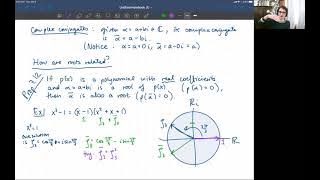
Introduction to additive combinatorics lecture 11.2 --- Part of the proof of Roth's theorem
Roth's theorem, one of the fundamental results of additive combinatorics, states that for every positive δ and every positive integer k there exists a positive integer n such that every subset of {1,2,...,n} of size at least δn contains an arithmetic progression of length 3. (This was late
From playlist Introduction to Additive Combinatorics (Cambridge Part III course)

Introduction to additive combinatorics lecture 12.1 --- Finishing the proof of Roth's theorem
Roth's theorem on arithmetic progressions states that for every positive real number δ there exists a positive integer N such that every subset of {1,2,...,N} of size at least δN contains an arithmetic progression of size 3. In the previous video of the course I proved two important lemmas
From playlist Introduction to Additive Combinatorics (Cambridge Part III course)

Calculus - The Fundamental Theorem, Part 1
The Fundamental Theorem of Calculus. First video in a short series on the topic. The theorem is stated and two simple examples are worked.
From playlist Calculus - The Fundamental Theorem of Calculus

Endre Szemerédi: In every chaos there is an order
Abstract: The chaos and order will be defined relative to three problems. 1. Arithmetic progressions This part is connected to a problem of Erdős and Turán from the 1930’s. Related to the van der Waerden theorem, they asked if the density version of that result also holds: Is it true tha
From playlist Endre Szemerédi

Taylor's Theorem for Remainders
Calculus: Given a Taylor polynomial for a function f(x) with n+1 derivatives, Taylor's Theorem gives us a method for estimating the error from the actual value. The example of f(x) = x^5 + 1 is given. For more videos like this one, please visit the Calculus playlists at this channel.
From playlist Calculus Pt 6: Sequences and Series

Theory of numbers: Fundamental theorem of arithmetic
This lecture is part of an online undergraduate course on the theory of numbers. We use Euclid's algorithm to prove the fundamental theorem of arithmetic, that every positive number is a product of primes in an essentially unique way. We then use this to prove Euler's product formula fo
From playlist Theory of numbers

Theory of numbers: Congruences: Euler's theorem
This lecture is part of an online undergraduate course on the theory of numbers. We prove Euler's theorem, a generalization of Fermat's theorem to non-prime moduli, by using Lagrange's theorem and group theory. As an application of Fermat's theorem we show there are infinitely many prim
From playlist Theory of numbers

The Campbell-Baker-Hausdorff and Dynkin formula and its finite nature
In this video explain, implement and numerically validate all the nice formulas popping up from math behind the theorem of Campbell, Baker, Hausdorff and Dynkin, usually a.k.a. Baker-Campbell-Hausdorff formula. Here's the TeX and python code: https://gist.github.com/Nikolaj-K/8e9a345e4c932
From playlist Algebra

Tom Sanders - Roth's theorem on arithmetic progressions
Roth's theorem on arithmetic progressions
From playlist 28ème Journées Arithmétiques 2013

1. A bridge between graph theory and additive combinatorics
MIT 18.217 Graph Theory and Additive Combinatorics, Fall 2019 Instructor: Yufei Zhao View the complete course: https://ocw.mit.edu/18-217F19 YouTube Playlist: https://www.youtube.com/playlist?list=PLUl4u3cNGP62qauV_CpT1zKaGG_Vj5igX In an unsuccessful attempt to prove Fermat's last theorem
From playlist MIT 18.217 Graph Theory and Additive Combinatorics, Fall 2019

Arithmetic progressions and spectral structure - Thomas Bloom
Computer Science/Discrete Mathematics Seminar II Topic: Arithmetic progressions and spectral structure Speaker: Thomas Bloom Affiliation: University of Cambridge Date: October 13, 2020 For more video please visit http://video.ias.edu
From playlist Mathematics

The Green-Tao theorem and a relative Szemeredi theorem - Yufei Zhao
Slides for this talk: https://drive.google.com/file/d/1RdgY6N869MN5lJwl2jv1HwIgWky6aW5C/view?usp=sharing The Green-Tao theorem and a relative Szemeredi theorem - Yufei Zhao Abstract: The celebrated Green-Tao theorem states that there are arbitrarily long arithmetic progressions in the p
From playlist Mathematics

The Green - Tao Theorem (Lecture 2) by D. S. Ramana
Program Workshop on Additive Combinatorics ORGANIZERS: S. D. Adhikari and D. S. Ramana DATE: 24 February 2020 to 06 March 2020 VENUE: Madhava Lecture Hall, ICTS Bangalore Additive combinatorics is an active branch of mathematics that interfaces with combinatorics, number theory, ergod
From playlist Workshop on Additive Combinatorics 2020

Calculus 5.3 The Fundamental Theorem of Calculus
My notes are available at http://asherbroberts.com/ (so you can write along with me). Calculus: Early Transcendentals 8th Edition by James Stewart
From playlist Calculus

The Green - Tao Theorem (Lecture 1) by D. S. Ramana
Program Workshop on Additive Combinatorics ORGANIZERS: S. D. Adhikari and D. S. Ramana DATE: 24 February 2020 to 06 March 2020 VENUE: Madhava Lecture Hall, ICTS Bangalore Additive combinatorics is an active branch of mathematics that interfaces with combinatorics, number theory, ergod
From playlist Workshop on Additive Combinatorics 2020

Topics in Combinatorics lecture 13.8 --- The slice rank of a diagonal 3-tensor
A result that has played a central role in additive combinatorics is the statement that for every positive c there exists n such that every subset of F_3^n of density at least c contains three distinct vectors x, y and z such that x + y + z = 0. For a long time, a major open problem was to
From playlist Topics in Combinatorics (Cambridge Part III course)

Timothy Gowers: The afterlife of Szemerédi's theorem
Abstract: Szemerédi's theorem asserts that every set of integers of positive upper density contains arbitrarily long arithmetic progressions. This result has been extraordinarily influential, partly because of the tools that Szemerédi introduced in order to prove it, and partly because sub
From playlist Abel Lectures

Fundamental Theorem of Algebra
The Fundamental Theorem of Algebra and some additional notes about how roots of polynomials and complex numbers are related to each other.
From playlist Modern Algebra